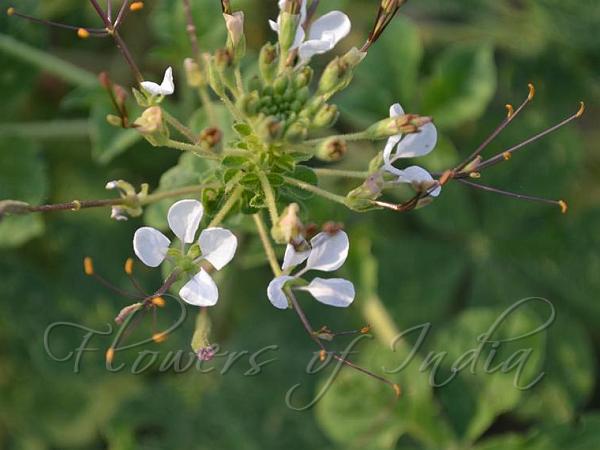|
| Wild Spider Flower |
|

|

|
|
|
|
Photo: |
Botanical name: Cleome gynandra Family: Cleomaceae (Spider Flower family)
Synonyms: Gynandropsis gynandra, Cleome triphylla, Cleome pentaphylla
Synonyms: Gynandropsis gynandra, Cleome triphylla, Cleome pentaphylla
Wild Spider Flower is an erect herbaceous annual herb, which is branched
and rather stout. Depending on environmental conditions, it can grow up to
1.5 m in height, but is usually 0.5-1.0 m tall. It has a long tap root,
with a few secondary roots with root hairs. Stems and leaf petioles are
thickly glandular. They exhibit variable pigmentations, from green to
pink, or violet to purple. Leaves are alternately arrnaged and stalked.
Each leaf has 3-7 leaflets, but most commonly 5 (rarely 3-4), which are
pinnately dissected and stalkless. They vary from obovate to elliptic in
shape, and are usually 2-10 cm long and 2-4 cm wide. They have finely
toothed margins or round ends. Inflorescence is quite showy, and is
usually up to 30 cm in length. The flowers have long stalks. The bracts
are much smaller than the leaflets. The flowers measure 1-2.5 cm in
diameter, and have 4 sepals, 4 narrow clawed petals, and 6 stamens with
long purple filaments, arising from a much elongated receptacle. The
petals are white, pale, pink or lilac. The fruit is a long-stalked, dry,
spindle-shaped capsule measuring up to 12 cm long and 8-10 mm wide.
Throughout Africa, the tender leaves or young shoots, and often the
flowers, are boiled and consumed as a potherb, tasty relish, stew or side
dish. Fresh leaves are used as ingredients in other mashed foods, and
dried leaves are ground and incorporated in weaning foods. The leaves are
rather bitter, and for this reason are cooked with other leafy vegetables
such as cowpea. Flowering: July-August.
| Identification credit: Prashant Awale | Photographed in Dhule, Maharashtra & Bayana, Rajasthan. |
• Is this flower misidentified? If yes,